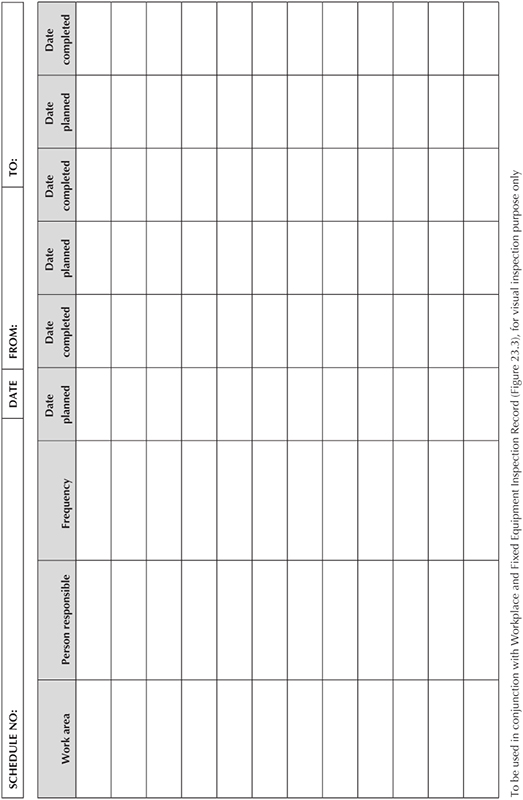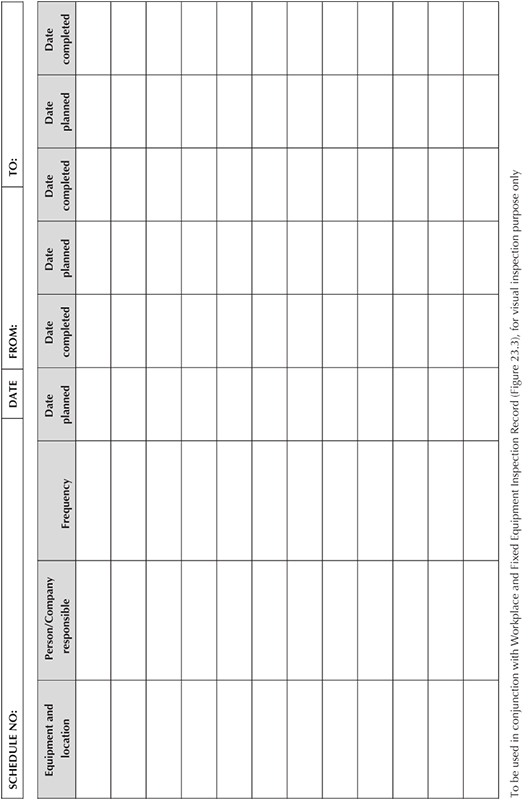23
Working Environment
Workplace is defined as any premises or part of premises which are made available to any person as a place of work. It also includes any part of the premises that employees have access to while at work, for example, corridor, staircase, entrance and exit. If an employee is working from home this also comes under the definition and the risks associated must be addressed.
- Workplace (Health, Safety and Welfare) Regulations 1992:
Every employer shall ensure that the health and safety of everyone is protected and that adequate welfare facilities are provided for people at work. Every workplace that is under his control and where any of his employees’ work, is maintained in an efficient state and in good repair.
- Health and Safety at Work etc. Act 1974:
Employers must maintain a safe place of work, with safe access and egress, a safe working environment with adequate welfare facilities.
- The Health and Safety (Signs and Signals) Regulations 1996:
Employers are required to use safety signs and appropriate signals where significant risks exist which cannot be controlled by any other means.
- Work at Height Regulations 2005 (as amended 2007):
Employers are required to assess the risks associated with working at heights and eliminate the task where possible. If it is not possible then control measures should be implemented to prevent people from falling.
- Construction (Design and Management) Regulations 2007 (CDM 2007):
The Client, this could be owner/occupier, must ensure, before work starts, that all construction work is adequately controlled. Designers of workplaces are required to ensure that risks are designed out of the workplace/building.
- Disability Discrimination Act 1995 (as amended 2005):
Employers/Occupiers/Owners must make reasonable adjustments to the physical features of premises to overcome barriers to access to the services.
- Occupiers’ Liability Act 1957 and 1984:
Occupiers of premises must take reasonable care for the safety of visitors to their premises. The duty of care extends to trespassers if the occupier for example is aware of the danger.
Employers
- They are required to ensure that the workplace is safe and healthy for employees and anyone else who may be affected including visitors/patients, including safe access to, and egress from, the premises.
- They are required to ensure that the activities undertaken are, so far as is reasonable, controlled to reduce the risk of injury to any persons.
- They are required to provide employees and visitors/patients with information and instruction – for example, the use of safety signs and signals. The colour and shape of the sign identifies its category. The main categories of safety signs are as follows:
- Warning – triangular, black pictogram on yellow background – for hazards, that is, flammable materials, ionising radiation controlled area
- Mandatory – round, white pictogram on blue background – telling people they must do something, that is, wear protective clothing
- Prohibition – round, red pictogram on white background – prohibiting certain activities, that is, smoking
- Safe condition – rectangular, white pictogram on green background – giving information about safety features such as fire exit routes
- They are required to undertake suitable and sufficient risk assessments to identify hazards, evaluate risks and implement control measures.
- They should restrict public access to hazardous areas.
- They should ensure the internal and external maintenance of premises.
- They must ensure the safe provision and maintenance of any ‘fixed equipment’, for example, air conditioning and gas boilers.
- They may have other specific duties as discussed throughout this chapter.
Occupiers and Those in Control of Premises
The following are the responsibilities in addition to the above duties:
- If the property is leased and you are the tenant ensure that the terms of the lease are agreed on before occupying the premises; it is important that you obtain this in writing. In most tenancy agreements, it is customary for the tenant to have the duty for health and safety.
- In most cases, tenants have a responsibility for internal and external maintenance and repairs.
- In shared premises, employers should cooperate with other tenants on health and safety issues and coordinate some activities, for example, fire evacuation procedures.
Employees
- Must cooperate with the employer to enable him to comply with legal duties
- Should report hazardous conditions or defects to the employer
- Should not intentionally interfere with or misuse anything that is provided for their health, safety and welfare
Public (Visitors/Patients)
- Should adhere to information and instruction provided by the owner/occupier. For example, they should follow instructions given on health and safety signs and signals such as fire evacuation.
- If providing assistance to a patient or a child, ensure that they take responsibility for that person or child at all times.
- Should not intentionally interfere with or damage anything that is provided.
Landlords
Responsibilities of the landlords will be dependent on the terms of the lease. However, the following provides a general guide:
- Keep the premises in a safe and habitable condition.
- Conduct electrical safety checks including wiring systems before leasing premises.
- In ‘shared premises’, the landlords are responsible for common parts. These are areas that are shared with other people, for example, this may include access to the premises and stairways.
- They are responsible for maintaining and checking that shared emergency equipment, for example, fire alarms and fire extinguishers on shared areas such as stairways are fit for use.
- They are responsible for lawfully evicting a tenant, by obtaining a signed court order, if the terms of the lease have been breached. An example might be if the tenant damages the premises.
- In some situations, the landlord may enlist the services of a managing agent who will act on behalf of the landlord under the terms of the lease, and will therefore have shared responsibilities.
The following provisions are considered necessary for all dental environments which are classed as enclosed (internal) workplaces. This is not an exhaustive list and further requirements can be found in The Workplace (Health, Safety and Welfare) Regulations 1992 (as amended):
- Maintenance of workplace, fixed equipment and systems
- Employers should have a planned workplace inspection schedule (Figure 23.1).
Figure 23.1 Workplace inspection schedule.

- Employers should discuss and agree on the frequency of fixed equipment maintenance work with the appropriate maintenance company (Figure 23.2).
Figure 23.2 Fixed equipment visual inspection and maintenance schedule.

- Maintenance work should routinely be carried out on all fixed equipment mentioned in this chapter and on the following:
- Gas supply and appliances
- Electric plug sockets
- Emergency lighting
- Water and air supply
- Any other fixed equipment as deemed necessary, t/>
- Employers should have a planned workplace inspection schedule (Figure 23.1).
Stay updated, free dental videos. Join our Telegram channel

VIDEdental - Online dental courses


